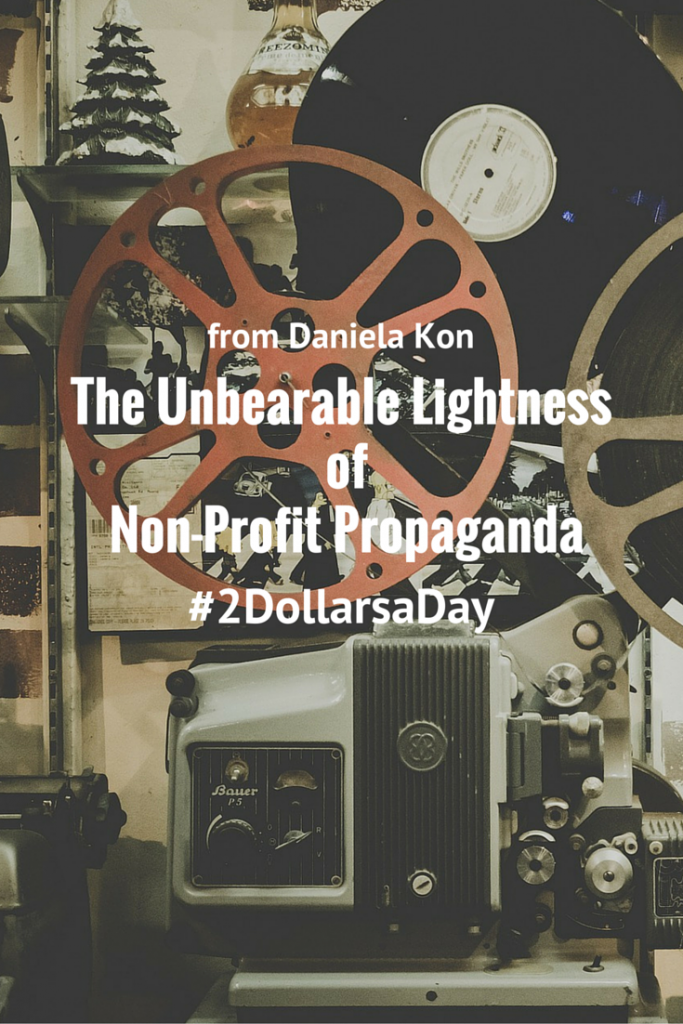The Unbearable Lightness of Non-Profit Propaganda
By Daniela Kon (originally published on HuffPost Impact and edited for use of the Two Dollar Challenge.)
The best way for me to answer what the role of SIMA is in poverty’s end, is to refer to why SIMA started in first place, which was a rocky journey of discovering how I as a filmmaker, and we as content creators working in the social change industry can either help to perpetuate the problems we spotlight or be part of empowering those that lead us to solutions.
Truthfully, I started SIMA (Social Impact Media Awards) because I fell from a horse in Jamaica in 2012. The horse’s name was “One Love.” I fractured my knee, couldn’t walk for a while, and couldn’t continue doing the work I had done for the past seven years, which was making films with humanitarian organizations and local activists, mostly between South East Asia and West Africa.
In those seven years on the road, as most people in international aid eventually do, I became brutally mindful of the BS that clogs up the social change industry, and specifically about the lies that we, as content creators, producers, filmmakers are communicating to the public about the glorious impacts that foundations and non-profits have on impoverished communities.
No, you did not change the lives of 500 kids in Kenya by feeding them for one day. No, you did not provide educational opportunities for the youth in Cambodia by building a school and giving them pencils. No, you did not ensure food security for farmers in Liberia by handing out sacks of rice. No, you did not provide access to clean water for a village in Senegal by donating a water pump!
Why? Well, amongst other things, because you have not taught any skills, you have not invested in people and in their ability to maintain and develop your projects further so they can sustain and benefit from them long after you have returned home. What you have done as an organization, what I am guilty of as a producer of media that echoes these lies, is legitimizing the existence of the organization through a seductive, aesthetically pleasing and dramatized piece of propaganda that compresses a complex issue into binaries of a broad need and a short-term solution for it, which in reality does nothing more than sticking a Band-Aid on the problem — preferably in conjunction with a savior-worshipping camera angle for the aid workers or volunteers, and a victimizing angle for the local children in abject poverty that through gifts transform into “everlasting smiles.” Audiences learn nothing about the reality of the children’s circumstances, and nothing about the actual process of the non-profit’s work that would allow them to judge if their efforts are actually addressing those circumstances adequately. On the contrary, I helped manipulate the story so no one would ever ask questions or doubt the value of what is happening, seducing viewers into trusting that they see all the truths they need to know to open their checkbooks.
CUT “Save a life today” – CUT – SLOW-MOTION on the half-naked baby girl with dirt on her face turning her head and looking straight into the camera – SUPERIMPOSE: “DONATE HERE: “non-profit URL” – CUT – non-profit LOGO – fade to black.

You feel me…!?
The trouble is that this type of no-context, no-transparency propaganda storytelling works! … It works for the organizations. It works to keep their donors happy… which arguably, eventually, potentially could provide for the financial bedrock for sustainable impact projects in the future (point taken!), but who is all this supposed to be working for right now? Seduced donors, or local populations who have no time to waste?
Here is what else this type of storytelling does. It helps to legitimize an entire crooked aid system that creates dependencies, that makes forced beggars out of developing communities while stroking the egos of western “white saviors” and their charitable complex. It perpetuates stereotypes of givers and receivers, heroes and victims, the all-knowing first-world educated and the backwards, impoverished illiterate. It robs local and marginalized people of their dignity and of their capacity to prosper independently — and by “it,” I mean “we” are responsible for all this, in the ways we approach and implement humanitarian assistance and in the ways we market and make films about it.
As content creators who work in this field, we provide the bridge, the checks and balances, the access to subjective truths in a space of collective self-serving delusion. We are responsible for what we communicate to our audiences. We are responsible for the choices we help the international community make about who and what to invest in, what initiatives to help scale, what outcomes to learn from, how to perceive those that we odd to be benefiting, and what systemic shortcomings to preserve in the archaic model of dependency driven international development.
Armed with this self-assuring understanding, and the conviction that local relief workers, activists and filmmakers share the exact same responsibilities when it comes to “helping” people — meaning assisting people in achieving what they seek to achieve and supporting those efforts that ensure a foremost dignified participation and representation of local communities in their own development process — I used my accident recovery time, limping and smoking way too many cigarettes, to dream up SIMA, as an antidote — as a medicine for the detrimental notions and lies I and so many of my colleagues helped spread.
It is our fourth year at SIMA now, scouting the planet for the type of films that set new standards for storytelling in the social sector, that serves communities and our understanding about the issues they face; that raises crucial questions about the state of our world — films that allow audiences to see behind the scenes of efforts working to create change, while creating dignified and transparent interpretations of global realities to remind us of our common humanity.
Spotlighting and distributing creative filmmaking that ignites and inspires us through integrity — that helps foster the kind of critical and global consciousness that is free from discrimination, separatism, and oppression — is working, and not just for donors.
My dear friend and hero, Daniela Papi, now Deputy Director at the Skoll Center for Social Entrepreneurship at Oxford and a SIMA Juror, was the brain behind our Impact Video Category at SIMA that asks innovative organizations to compete for recognition of “HOW” they do their work, not only for “what” they do and “why.” Through this category, we have been able to find and support projects that are mind-blowingly brilliant, projects that build capacity, that invest not in “things” but in people and deserve our greatest attention as models for skill-sharing, storytelling, for the impact they have on society and the lessons they teach us about the world and our own potential.
Check out our Impact Cinema lineup at this year’s Two Dollar Challenge and dare to be inspired.
++++++
Daniela Kon, Executive Director of SIMA (Social Impact Media Awards), Documentary Filmmaker, Impact Producer, International Advocacy Consultant

 Previous Post
Previous Post Next Post
Next Post